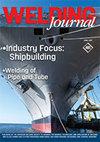高强度钢焊接金属的冶金设计规则
IF 1.4
3区 材料科学
Q2 METALLURGY & METALLURGICAL ENGINEERING
引用次数: 3
摘要
对所选Fe-C-Mn高强度钢屏蔽金属电弧焊金属的膨胀分析表明,平衡的Ti、B、Al、O和N添加降低了奥氏体向铁素体转变的起始温度(TS)。这些微合金添加剂必须与以下用于成分控制的目标水平相匹配:400 ppm(0.04 wt%)的Ti、40 ppm(0.004 wt%)的B、200 ppm(0.020 wt%)的Al、400 ppm(0.04wt%)的O和优选低于80 ppm(0.008 wt%)的N,以确保有效脱氧,形成复杂夹杂物,并将其分布以使得能够开发高抗断裂的精细焊接金属微观结构。对于这些微合金添加剂,除了N之外,避免富端和贫端可能是更明智的,N应保持在贫端,优选地远低于80ppm(0.008wt%)。平衡添加的Ti、B、Al、O和N在降低28或100 J吸收能量的夏比V型缺口(CVN)试验温度方面提供了近100°C的转变。对再热焊缝金属的膨胀评估表明:1)与根据组成方程计算的奥氏体-铁素体转变温度相比,平衡的Ti、B、Al、O和N的添加使实际TS温度降低了约60°C;2) 大于100ppm(0.010wt%)的N有效地抵消了Ti、B和Al添加在降低转变温度方面的有益作用;和3)在N含量远低于80ppm(0.008wt%)时,较低的TS温度和较窄的开始-结束(TS–Tf)温度范围都有助于实现优异的焊接金属CVN冲击韧性。本文章由计算机程序翻译,如有差异,请以英文原文为准。
Metallurgical Design Rules for High-Strength Steel Weld Metals
A review of a dilatometric analysis of selected Fe-C-Mn high-strength steel shielded metal arc weld metals showed that balanced Ti, B, Al, O, and N additions reduced the austenite-to-ferrite transformation-start (TS) temperature. These microalloy additions must match the following aim levels for composition control: Ti at 400 ppm (0.04 wt-%), B at 40 ppm (0.004 wt-%), Al at 200 ppm (0.020 wt-%), O at 400 ppm (0.04 wt-%), and N preferably below 80 ppm (0.008 wt-%) to ensure effective deoxidation, form complex inclusions, and distribute them to enable development of highly fracture-resistant refined weld metal microstructures. It may be wiser to avoid the rich and lean ends for these microalloy additions, except N, which should be held at the lean end, preferably much below 80 ppm (0.008 wt-%). The balanced Ti, B, Al, O, and N additions offered nearly a 100°C shift in lowering the Charpy V-notch (CVN) test temperature for either 28 or 100 J absorbed energy. Dilatometric evaluations of reheated weld metals showed that 1) the balanced Ti, B, Al, O, and N additions lowered the actual TS temperature by about 60°C compared to the calculated austenite-to-ferrite transformation temperature obtained from the constitutional equation; 2) N with more than 100 ppm (0.010 wt-%) effectively nullified the beneficial effects of Ti, B, and Al additions in lowering the transformation temperature; and 3) at N content much below 80 ppm (0.008 wt-%), both a lower TS temperature and a narrow start-to-finish (TS–Tf) temperature range helped in achieving exceptional weld metal CVN impact toughness.
求助全文
通过发布文献求助,成功后即可免费获取论文全文。
去求助
来源期刊

Welding Journal
工程技术-冶金工程
CiteScore
3.00
自引率
0.00%
发文量
23
审稿时长
3 months
期刊介绍:
The Welding Journal has been published continually since 1922 — an unmatched link to all issues and advancements concerning metal fabrication and construction.
Each month the Welding Journal delivers news of the welding and metal fabricating industry. Stay informed on the latest products, trends, technology and events via in-depth articles, full-color photos and illustrations, and timely, cost-saving advice. Also featured are articles and supplements on related activities, such as testing and inspection, maintenance and repair, design, training, personal safety, and brazing and soldering.
 求助内容:
求助内容: 应助结果提醒方式:
应助结果提醒方式:


